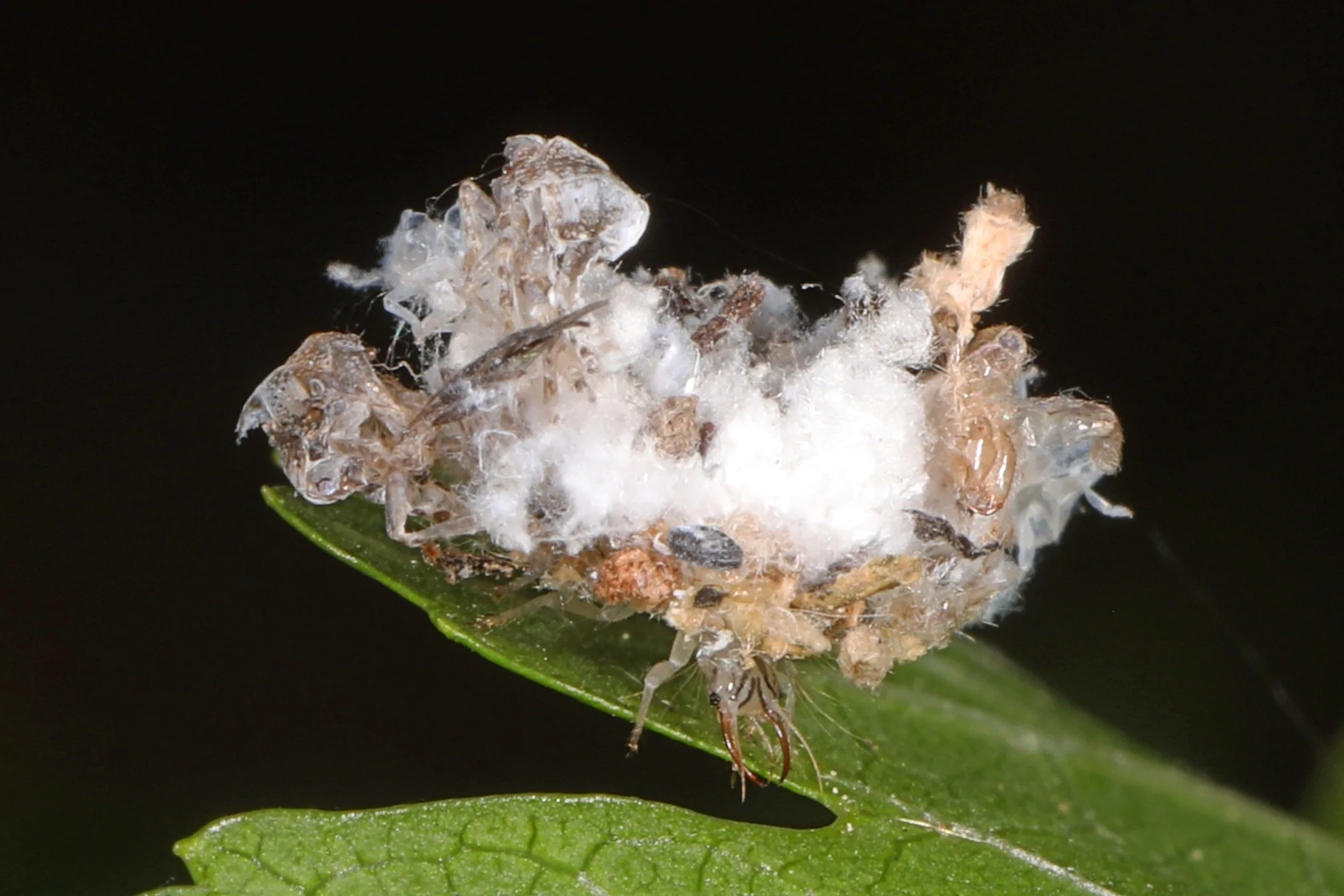Photo: Green Mantidfly, Judy Gallagher
Judy Gallagher
June 2025
I went to North Carolina recently, searching for early season dragonflies. We searched for dragonflies by day, but at night we set up a black light to see what other insects we could attract. The highlight was a Pleasing Lacewing, an insect I had only seen once before, and it is the inspiration for this month's column.
Pleasing Lacewings are a family in order Neuroptera, or nerve wings. This is the oldest insect order that undergoes complete metamorphosis. Other members of the order include Antlions, Owlflies, Mantidflies and additional families of Lacewings. Adults in this order have four membranous wings with many veins, and chewing mouthparts. Most Neuropteran larvae are voracious predators. Some adults are also predators, but many feed on nectar or don't feed at all as adults.
Pleasing Lacewing - Nallachius americanus, Judy Gallagher
There are about 70 species in the Pleasing Lacewing family, only one of which occurs in our area. Pleasing Lacewing larvae prey upon beetle larvae that are under bark, and scientists aren't sure what the adults eat.
Golden-eyed Lacewing - Chrysopa oculata (member of Green Lacewing family), Judy Gallagher
There are several other Lacewing families, including Green Lacewings, Brown Lacewings, and Beaded Lacewings. There are at least 1,300 Green Lacewing species in the world, and they are the ones we see most commonly in our area. Male Green Lacewing adults vibrate their abdomens and send a signal out on the plant they are resting on, and females can feel these vibrations and respond. Each Green Lacewing species song is unique. Adult lacewings in subfamily Chrysopinae can detect the sound of bats with auditory organs in the large veins of their front wings. Some species are called Stink Flies because they release a stinky odor when threatened.
Green Lacewing larva with discarded body parts of its prey, Judy Gallagher
I mentioned before that Neuropteran larvae are predators. Some Green Lacewing larvae use discarded body parts of their prey to disguise themselves. Some decorate themselves with lichen, also as a disguise, but other larvae don't bother concealing themselves from predators. Green Lacewing larvae are particularly effective predators of aphids, and are used as a biological control. They're sometimes referred to as Aphid Lions or Aphid Wolves.
Lacewing larva preying on aphids, Judy Gallagher
Brown Lacewing larvae and adults also eat aphids. Confusingly, not all adults of the Brown Lacewing family are brown. Some are green, and some adult Green Lacewings are brown. This presents a challenge when I try to identify lacewings to species.
Antlion - Brachynemurus abdominalis, Judy Gallagher
Antlion larvae are, as the name suggests, predators of ants. But they're not too picky about prey and will eat almost anything. Some species build funnel-shaped pit traps in the ground. The Antlion larva, also known as a Doodlebug, settles at the bottom of the trap with its jaws projecting upwards. Prey that slips into the trap goes right into the Doodlebug's mouth. The arrival of food is unpredictable, and Antlion larvae have slow metabolisms so that they can survive when prey is unavailable. Adult Antlions are nocturnal, and they don't live very long.
Green Mantidfly - Zeugomantispa minuta, Judy Gallagher
My favorite members of order Neuroptera are the Mantidflies, which look like a cross between a Lacewing and a Praying Mantis. Despite their resemblance to Praying Mantises, they aren't closely related. The larva of many Mantidfly species are specialized predators of spider eggs. They find and either penetrate egg sacs, or hitch a ride on an adult spider. Adults prey on small moths and other insects. Green Mantidfly larvae penetrate spider egg sacs, chewing through the silk casing with their specialized jaws.
Say's Mantidfly - Dicromantispa sayi, Judy Gallagher
Mantidfly species that can't chew their way inside spider egg sacs climb onto a female spider and wait until she lays her eggs. The larva gets wrapped up with the eggs in the egg sac. If the Mantidfly larva climbs onto a male spider, it switches to the female while they are mating, or, even better, when the male spider is being eaten by the female spider. There also are some Mantidfly species larvae that prey on beetle larvae, bee or wasp larvae and caterpillars.
I am fascinated by the way species interact with their environment. I hope you get to see some Neuropterans interacting this summer.
View more of Judy’s articles on A Closer Look: Nature All Around Us (formerly Observations from Meadowood).







